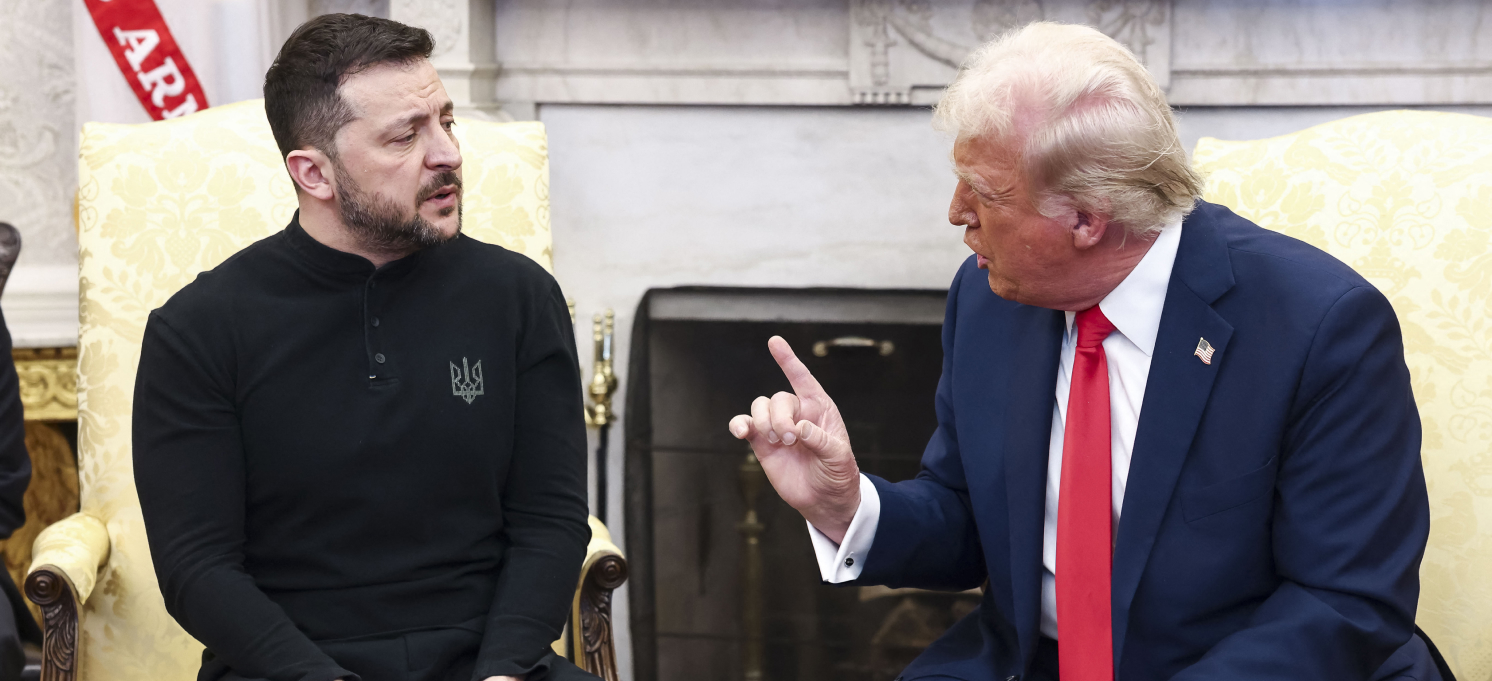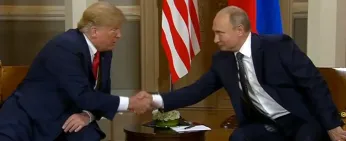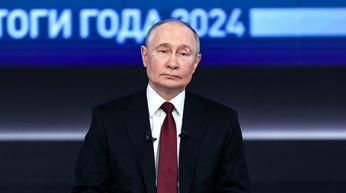
Russia hopes for sanctions relief
Hello! Welcome to your weekly guide to the Russian economy — written by Alexandra Prokopenko and Alexander Kolyandr and brought to you by The Bell. This week our top story looks at Russian hopes for sanctions relief as part of any deal to half the Ukraine war. We also cover mixed signals on whether the economy is slowing down and what it means for interest rates and inflation.
As Trump prepares his Ukraine peace plan, Moscow eyes an easing of sanctions
Ahead of next week’s Munich Security Conference, markets and politicians are anticipating an announcement from Donald Trump about his proposed Ukraine peace plan and the possibility of ceasefire talks — especially since both Kyiv and Moscow have indicated their readiness to open negotiations of some kind.
What’s going on?
The buzz around US President Donald Trump’s proposed peace plan has been building for days. Bloomberg first reported that Trump’s special envoy Keith Kellogg might present the plan to end the war at the Munich Security Conference next week. Kellogg initially seemed to confirm the reports, before strongly denying them. According to him, the plan is now for him to meet with European leaders in Munich and then report back to Trump who will, of course, unveil his plan personally.
Trump said Friday he would “probably” meet Ukrainian President Volodymyr Zelensky next week — implying it would be in Washington as he ruled out travelling to Kyiv — and also said he would “talk to” Russian President Vladimir Putin to try to bring about an end to the “ridiculous” war. In remarks to reporters, the US President also doubled down on his calls to be given access to Ukraine’s “rare earths” — critical elements used in electronics — as part of any US brokered deal or security offer to halt the three-year war.
Markets reacted sharply to rumors of a looming deal, with shares in some companies linked to Ukraine — and affected by sanctions on Russia — rising. Ukrainian metals company Ferrexpo jumped 18.2% on Thursday, while the MHP agro conglomerate was up 7.6%. ArcelorMittal, which owns a major steel plant in Kryvyi Rih climbed 13.3% and shares in Raiffeisenbank, which has large exposure to both Ukraine and Russia, rose 12.5%. Ukrainian bonds also gained. It is clear that the market is anticipating both a ceasefire and an easing of sanctions against Russia. Rumors abound about contacts between Moscow and Washington and behind-the-scenes progress in reaching an elusive compromise.
There is no official confirmation from either side, but the latest rhetoric hints at some movement. For the first time Zelensky spoke this week of his willingness to enter face-to-face talks with Putin. Putin has repeatedly ruled out direct talks with Zelensky, but at the end of January said he was “ready to assign people to conduct these talks.”
Both sides are likely under threats from the White House to cooperate. Ukraine faces the possible loss of crucial US military aid, while Russia could be hit with further sanctions. Trump has already said that he wants a deal with Saudi Arabia to force down oil prices. He was notably coy when asked if he had spoken with Putin secretly, saying: “I don’t want to say that.” His recently appointed Secretary of State Marco Rubio has said that sanctions are the main lever of pressure the US has to exert on the Kremlin.
Moscow has already seized the gauntlet, saying it is willing to negotiate with the US “in a tough bargaining mode, taking into account the realities on the ground and national interests,” deputy foreign minister Sergei Ryabkov said, echoing the position put forward by Putin and Foreign Minister Sergei Lavrov. Putin himself has repeatedly signalled he is waiting for Trump to make the first move. He claimed that “if Trump’s victory was not stolen in 2020, there would be no war” and that the new US president “will quickly bring Europe’s political small fry into order.” These statements should be seen as a sign that Moscow is ready to negotiate directly with Washington, without the involvement of Kyiv or other European countries. For Putin, one-on-one talks with Trump are his best-case scenario.
In terms of what Russia wants from a deal, officials have repeatedly said any deal must recognise “the realities on the ground” — a reference to Moscow’s control of around a fifth of Ukrainian territory — and that a Ukrainian future in NATO is inadmissible. The idea of European peacekeepers being deployed to Ukraine is also unacceptable, not least because it would make it harder for Russia to re-invade in the future.
Sanctions relief?
Equally important for the Kremlin is the lifting of Western sanctions. In summer 2024, Putin said the removal of all sanctions was an essential precondition for Russia to enter talks.
Russia currently faces more sanctions than any other country in the world, a combined 15,000 measures. The US, the EU, Britain, Canada, Ukraine, Australia, Japan and South Korea have all imposed sanctions — but the Kremlin is only seriously concerned about those imposed by Washington, Brussels and London, a source close to a senior official in the presidential administration said. According to them, Putin’s position has not changed since 2014: “all sanctions are unjustified and should be lifted.”
“It’s understood that Trump can only lift US sanctions, and only partially — but that would already be significant,” another federal official told The Bell. “But everyone remembers Jackson-Vanik, so there are no illusions,” they added, referring to a 1975 amendment which restricted US-Soviet trade following a ban on Jews emigrating from the Soviet Union. The amendment remained in force until 2012, long past the Soviet Union’s collapse, when it was replaced by the Magnitsky sanctions bill.
Even a partial lifting of US sanctions would be a serious blow to the current international sanctions regime. Western countries are not obliged to agree on what sanctions to levy, with agreements, for instance between the G7 nations, coming voluntarily. To the Kremlin, a unilateral US move to scrap some sanctions would be a major crack in that coalition. Moscow could also be satisfied by a less radical step, such as a pledge not to intensify the implementation of existing sanctions.
Russia has performed miracles in adapting its economy and its decision-making systems amid ever-tightening sanctions over the last three years. Rules allowing parallel imports mean Russians hardly notice that Western consumer brands stopped selling directly to Russia, logistics to the East have improved rapidly in a short time, a parallel financial infrastructure has been established, a network of trade and financial intermediaries has flourished, and hundreds of shadowy schemes allowing Moscow to acquire sanctioned goods, including for its military, have popped up. “If things don’t get any worse, we’ll cope,” the head of a company that imports electronic components told The Bell. “The latest round of energy sanctions looks significant but, in fact, turned out to not be critical. If nobody presses, we can adapt,” a person close to the board of one energy company told The Bell.
The final round of sanctions imposed by the Joe Biden administration on Russia’s oil companies were the biggest ever on Moscow’s energy sector. But they will have only a temporary — albeit significant — impact on Russian exports, Viktor Kurilov, a senior analyst at Rystad Energy said in a recent report. The price cap on Russian oil remains at a level that is comfortable for the federal budget ($60/barrel) and Russia can restructure its intermediary chains and use its shadow fleet, which since early 2023 has been growing by about 10 tankers a month, to keep exports flowing. Data from January supports this theory. Despite market turbulence, oil-related tax revenues were at 572.6 billion rubles ($5.8 billion) in January, around 14% higher than during the same period last year, Bloomberg calculated (although the base oil price used for calculating taxes was around 2% higher).
Opinions vary among the Russian businesses and officials asked by The Bell about which sanctions they would like to see eased. Manufacturers and officials responsible for the “real economy” are most concerned with import restrictions and problems with cross-border payments. Macroeconomists and finance officials are more worried about the latest oil sanctions and the potential for them to affect demand for Russian oil in third countries, particularly India and China.
It is worth noting that no one The Bell spoke to believes all sanctions will be lifted. But they do expect a partial, targeted easing. For example, a source at a major airline said that easing sanctions on air transportation and the import of parts for aircraft would be a big help, as would anything related to softening restrictions on financial institutions. “Yes, we have learned a lot: how to get a pool of components and how to repair them. We have partners in Asia. We’re operating safely. But it would be better without sanctions,” they said. The CEO of an importer was mostly unhappy with financial sanctions and strict compliance protocols. “But we’ve all gotten used to them and learned to live with that. It just got more expensive,” they said.
Why the world should care
Putin, just like Trump, likes big package deals. It seems that everybody is moving in that direction. Possible talks between the US and Russia without Ukraine and Europe might lead to compromise, but in the long term they will likely work against security and stability in the region. The Trump administration cannot lift all sanctions, while a partial easing is unlikely to persuade Putin to make any serious concessions in return — especially since sanctions on Russia have nothing to do with Moscow’s concerns over Ukraine’s drift towards Europe. Russian businesses have largely learned to live with the restrictions, while still conceding that things would be much better without them. Nevertheless, any move from Washington on sanctions relief would, in Putin’s eyes, represent a success and signify the collapse of the Western “anti-Russia” coalition.
Mixed signals on economic slowdown
A slowdown in borrowing and “normalisation” in government spending are bringing the economy back from a phase of “overheating,” central bank analysts wrote in a report this week, the regulator’s final monetary policy publication before the Feb. 14 decision on interest rates. But for all that to result in a deceleration in inflation, the key rate must remain high for a long time to come and “the budget must remain within the approved parameters,” it said.
- Sanctions, supply-side restrictions, and a reduced harvest all contributed to higher inflation in December and January. Consumer price inflation climbed to 14.2% in December on a seasonally adjusted rate (SAAR), up from 13.8% in November. The impact of the weakening ruble was clearly visible in prices in the non-food sector — electronics and foreign cars were significantly more expensive, and fuel prices were also higher.
- Components are also now making a greater contribution to inflation. Against a background of high consumer activity, there was increased influence of demand-side factors on inflation throughout the fall.
- The rate of inflation also remained high in January, with prices up 1.14% from Jan 1-27. Although one-off factors had an impact, there is no evidence of any sustained slowdown in price growth, the Central Bank’s analysts concluded.
- Seasonally-adjusted GDP growth in the fourth quarter accelerated compared to the previous three-month period. This might be partly due to the usual end-of-year rush in budget expenditures. Official statistics published Friday showed that GDP increased 4.1% in 2024 — above state forecasts
- Across industry, the situation varies according to the sector. In November, total output barely changed (+0.1% month-on-month, seasonally adjusted). Extractive industries showed a slight increase (+0.3%), mostly due to growth in volumes, while the manufacturing sector slowed to 0.1% growth following more rapid expansion in previous months.
- The slowdown in lending is increasing leading to cooling demand in the economy, with the market feeling the effect of the Central Bank’s tightening monetary conditions and tighter macroprudential requirements. In December, the credit impulse — a measure of the scale of new borrowing as a proportion of GDP — remained negative, continuing to decline in both the consumer and corporate segments.
Why the world should care
When an economy is already using all available resources — factories at full capacity and almost no spare labor — rapid long-term growth is impossible. In such a situation, an artificial surge in demand (for example, due to a rush of state orders or cheap credit) leads not to increased productivity, but surging inflation. Over time, inflation will only increase and then the economy inevitably starts to slow, potentially falling into recession. In reality there is no real choice for how to avoid this. Either the economy slows of its own accord or inflation surges and then the economy crashes. The central bank is openly calling on the state to restrain its appetite for more spending, before a recession becomes inevitable.
Figures of the Week
From Jan. 28 to Feb. 3, weekly inflation slowed from 0.22% to 0.16%. Annual inflation fell from 9.95% to 9.92%. Food inflation over the week was 0.27%. These price dynamics show that the current monetary situation is not strict enough and it is too early to start reducing interest rates.
The outlook for inflation and the exchange rate in 2025 has worsened, according to the latest Central Bank survey of 34 Russian analysts. They anticipate that year-end inflation will be 6.8% in 2025 (up from a previous forecast of 6%), and 4.6% in 2026 (up from 4.5%) . However, analysts are increasingly hopeful of a fall in interest rates: the December forecasts anticipated an average key rate of 21.3% in 2025. That has now declined to 20.5% for this year, 15% in 2026 and 14.6% in 2027. The median exchange rate forecast predicts the US dollar will be worth 104.7 rubles this year (compared with 102 in December), 108.8 rubles in 2026 and 110.4 rubles in 2027.
The volume of consumer loans fell 28.2% to 441.5 billion rubles in January 2025, according to Frank RG’s preliminary estimates. In Jan. 2024 the drop was more noticeable — at 41.9%. The greatest fall this year was in mortgages (54.1%), followed by auto finance (26.5%). The volume of loans in the short-term point of sale (POS) sector fell 5.8% with only cash borrowing (+6.4%) increasing.
Further reading
Addicted to War: Undermining Russia’s Economy
The Russian Opposition in the Eyes of Russians in Russia and Abroad: Mikhail Khodorkovsky
Down But Not Out: Demoted Russian Officials Seek to Regain Former Influence





